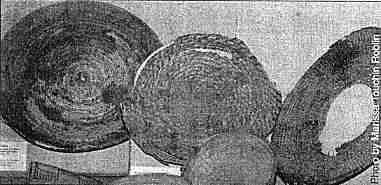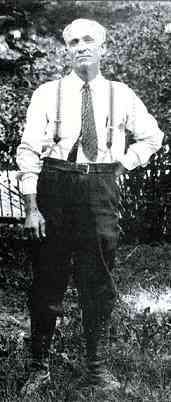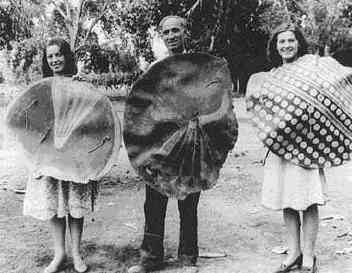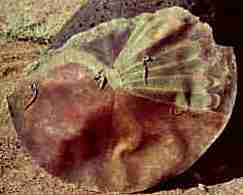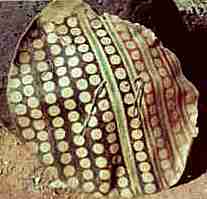Those of you who have been Hickmans for a long time will probably know of three sisters who guided the Hickman Reunion organization for many years from the 1960s to the 1990s. Their names were Golda Busk, Leona Holt, and Devona Hancock. They were the children of Ephraim P. Pectol and his wife Dorothy Hickman Pectol. Their mother was a daughter of Deseret and Dorothy Hickman; Deseret was a son of William Adams Hickman through his fourth wife Sarah Basford Meacham. The Pectols lived in Torrey, Utah long before there was a national park in the area. This was also before there were Federal laws governing the collecting of antiquities, and prehistoric artifacts from the early Indian tribes were there for the taking. In his spare time, Ephraim gathered quite a large collection. This kind of activity is no longer encouraged, unless you want to get to know FBI agents on a first-name basis. The family recently loaned the artifacts to the Brigham Young University anthropology museum at Provo, Utah.
As a Hickman or prospective Hickman, you are invited to go see the exhibit. A link at the bottom of this page will tell you how to get there, and the following articles will let you know what to expect. Please be aware the museum is usually not open on weekends.
Museum Celebrates New Exhibit
by Michelle Kramer, (801) 378-5856
PROVO, Utah (June 13, 2001)
A unique turn-of-the-century collection of Fremont and Anasazi artifacts went on display at the Brigham Young University Museum of Peoples and Cultures beginning Friday, June 22, 2001.
The new exhibition, "In Search of Relics: The Pectol-Lee Collection of Capitol Reef," will join the already-running exhibit "Kachinas and the Hopi Worlds" at the museum, located at 700 N. 100 E. in Provo.
The street in front of the museum was closed and demonstrators of traditional native crafts and skills such as flintnapping (making arrowheads), cordage-making and corn grinding were available to help visitors try their hand at these ancient crafts.
For more information, contact the museum at (801) 378-6112. The museum is open weekdays from 9 a.m. to 5 p.m.
The Pectol-Lee collection features Fremont and Anasazi artifacts found by Ephraim P. Pectol and Charles W. Lee in the Capitol Reef region during the early 1900s. Pectol and Lee were archaeology buffs "looking for connections to their religion," according to Mauri Liljenquist, curator of education at the Museum.
Some of the artifacts include part of a deer-hunting costume and a one-of-a-kind basketry cradleboard nestling a Fremont figurine. Baskets, pottery and tools are also part of the collection. About half of the collection will be on display in the exhibit.
Liljenquist said museum staff negotiated with representatives of the Ephraim P. and Dorothy Hickman Pectol Family Organization for several months to have the Pectol-Lee collection come to the museum. (Charlie Lee collected some of the items. Now all of the items are Pectol family items.)
The collection was made available to the museum under a five-year loan agreement (until the year 2005).
"The museum staff is very grateful to have this unique collection available for exhibition," Liljenquist said. "We feel that visitors will be drawn to the mystery and intrigue of this collection and its connection to a history most of us share."
It is clear from early accounts that Pectol felt the same way. Of the two principal collectors, Pectol stands out as being the source of the largest number of objects. Pectol's collection of artifacts made him one of the preeminent collectors of early Native American material culture in southern Utah.
"It is exciting to have these ancient relics available for others to enjoy," Liljenquist said.
The BYU Museum of Peoples and Cultures is unique from many other museums in that it is run by students and volunteers. Students are involved in every aspect of the museum, according to Liljenquist, who noted that the museum has about 5-10 volunteers at a time.
Volunteers are encouraged to work with an aspect of the museum that interests them, says Liljenquist. Previous volunteers have worked with public relations, designed teaching kits and developed a self-guided tour for a recent exhibit.
Michelle Muncey and Leslie-Lynne Sinkey are the student curators for the Pectol-Lee collection. Muncey is an undergraduate majoring in history and Sinkey is a graduate student in anthropology. Both students were enrolled in Anthropology 349 during winter semester and began as volunteers with the museum.
"Preparation for this exhibit began in the fall [of 2000], said Liljenquist. "Our student curators took classes, wrote grant proposals, designed cases and wrote labels in preparation for the opening of the Pectol-Lee collection."
<<<<<O>>>>>
A Look into the Past
The Fremont Indians Coming to Life
by Marissa Touchin Roblin
The Museum of Peoples and Cultures celebrated its third annual block party on June 22, 2001, unveiling artifacts from the Pectol-Lee Collection. The exhibition, In Search of Relics: The Pectol-Lee Collection of Artifacts from Capitol Reef, brings to light the Pectol and Lee families' involvement in collecting important artifacts from southern Utah. The exhibition, now on display in the Museum's small gallery, also contains information about the Fremont Indians' life and culture.
Ephraim P. Pectol and Charles W. Lee of Torrey, Utah, found many fascinating artifacts in the rock shelters and caves of Utah's Capitol Reef in the early 1900s. Due to Pectol and Lee's interest in the artifacts, they spent most of their leisure time relic hunting. Pectol and Lee's artifacts attracted the attention of many archaeologists. Among the most fascinating artifacts are a small cradle board containing a Fremont figurine and a deer headdress possibly worn by a highly authoritative person such as a shaman. Both are on display at the Museum. These two artifacts, which have never been researched extensively, are the showcase items for the exhibition. The research of these two important artifacts--according to archaeologists--might hold pertinent information and answers to questions about the Fremont Indians' way of life, cultural traits, and mysterious disappearance.[1]
Although the Fremont Indians dwelled in pithouses, they used rock shelters and caves to hide or store their belongings. For unknown reasons, they left their belongings and never came back for them. During the course of the years, the rock shelters and caves were also used by the Anasazi and Numic Indians for storage. Over hundreds of years, the caves and rock shelters protected the various artifacts from the rain, snow, and wind. In fact, most of the artifacts in the Museum's exhibition are almost in their original state.[2]
This exhibition also highlights other artifacts, such as the numerous baskets and pottery pieces found by Pectol and Lee. The baskets and other artifacts contain valuble insights into the Fremont and Anasazi's agricultural life. By studying their agricultural tools, pottery, clothing, and baskets, archaeologists have found the Fremont Indians to be distinct from the Anasazi and all other American Indian groups.
Although Noel Morss, an archaeologist, had already found the Fremont Indians to be archaeologically different from the Anasazi and Numic Indians in the 1920s, the Pectol-Lee artifacts have helped archaeologists further distinguish the Fremont from other Indian tribes. By comparing the Pectol-Lee artifacts to other findings, archaeologists have found the Fremont Indians to have lived in other places in southwestern Wyoming, western Colorado, eastern Nevada, and southern Idaho.[3]
Through the hands of Pectol and Lee, many artifacts have been brought to the public's knowledge for observation, study, and research. Now we are able to study ancient Indian life found in Utah. The Pectol-Lee collection will be available to the public until the year 2002. For more information call the Museum of Peoples and Cultures at (801) 378-6698.
NOTES:
2. Ibid.
3. Ibid.


